Today I'm going to show you a hand that Daniel "Jungleman" Cates played on Hustler Casino Live. It was $200/$400, and Jungleman deviated from the conventional line very much, using information he received from his opponent to adjust.
So, Daniel is in first position, he gets AQs and makes a standard raise.
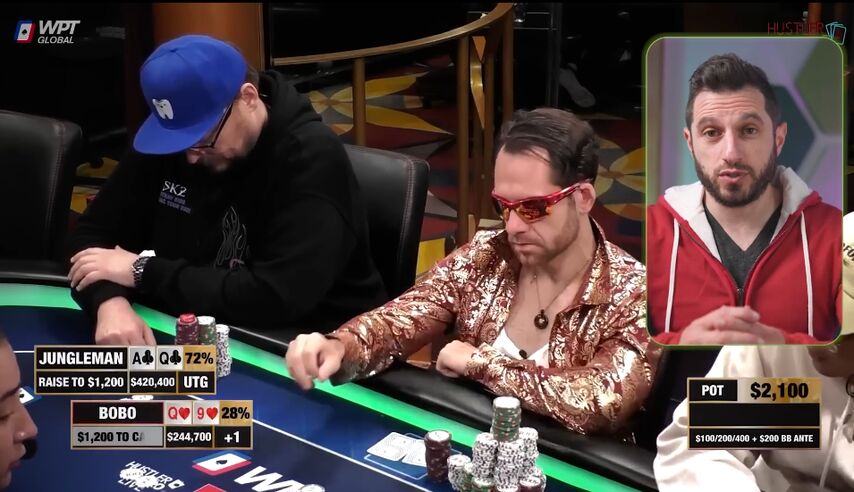
To his left, Bobo 3-bets to $3,000 with Q9s. A little loose, but not completely crazy action.
The rest of the players fold and Jungleman 4-bets to $10,000. This is not a mistake either – in the solver world, such a 4-bet is made with a low frequency. Well, if Daniel knows that Bobo is capable of very light 3-bets, this decision becomes even better.
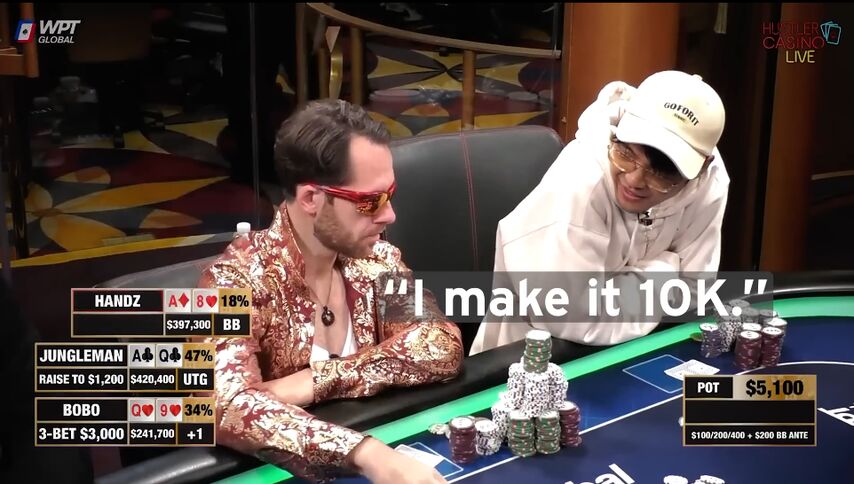
– "10 thousand? I like it,” Bobo says and calls.
Yes, I forgot to mention that they are playing 600 blinds deep. In theory, this should make the player in position play more aggressive and looser, and the player out of position play tighter. This partly explains and justifies Bobo's line.
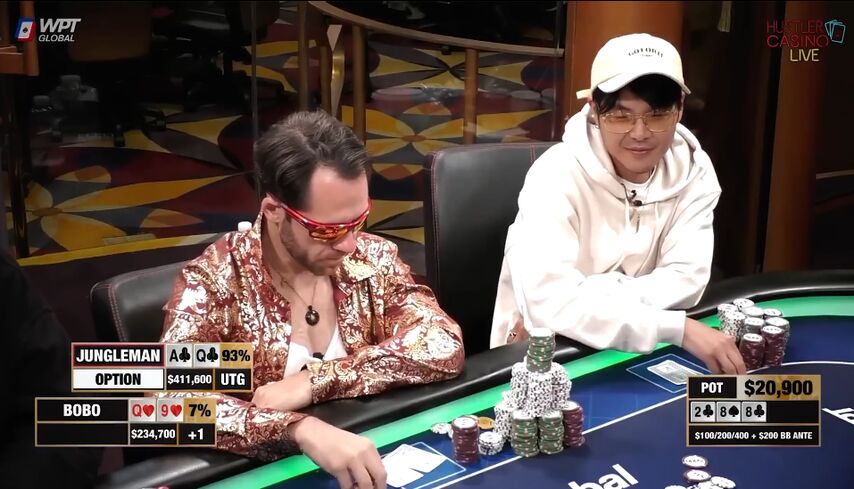
On the flop, Jungleman bets about a third of the pot, $6,500. An expected sizing that he uses with perhaps his entire range. Small bets help him maximize the advantage of overpairs and even just overcards. Such an advantage cannot be realized by large bets on several streets, since only trips will remain in the opponent's range rather quickly.
There are more nut combinations in Bobo's range. Jungleman's trips – 98s, sometimes A8s. For Bobo, an eight is more common: 98s, 87s, J8s, Q8s. Such deep-deep hands are very likely to 3-bet-call. Two deuces are extremely unlikely for both, two eights are also, although Bobo, perhaps, will sometimes have them. However, the advantage of the nuts is not decisive here, because they are too small a part of the range of each of the players.
So Jungleman's standard bet, and then Bobo raises him to $20,000.
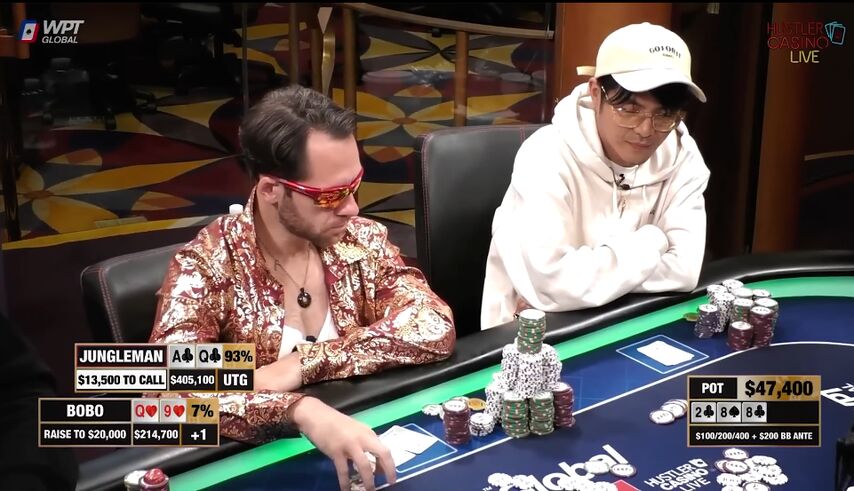
Interesting solution!
Both in theory and in practice, players in position with a small frequency here raise hands like , , . It's a raise partly for defense, partly for value, partly to make it easier to play later: we take advantage of the fact that our range is well protected by trips, and we can afford thin raises. A small sizing is chosen precisely so as not to represent strictly trips – raises with pocket pockets and bluffs are mixed into it. has no need to bluff, just fold them!
The Jungleman who flopped the nut flush draw calls. I don't have a 3-betting range on this texture – I can only raise further if I somehow read my opponent. Call is the standard.
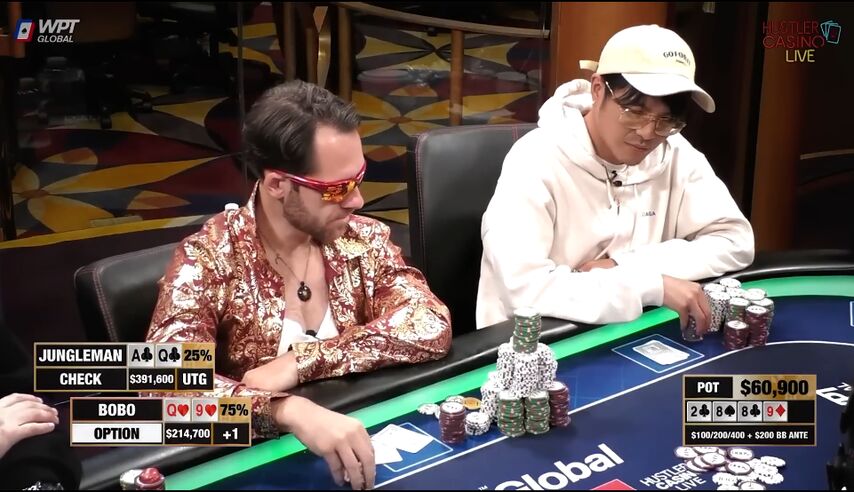
On the turn, Jangleman checks, and Bobo continues with a $25,000 bet. It is on this street that the hand becomes especially interesting.
Bobo was bluffing on the flop, but now he's hit top pair. With it, he continues to bet for thin value and defense. Now he has a hand of about the same strength that he portrays – like, for example, .
And here Jungleman decides to rely on the reading skills of his opponents. Under normal circumstances, the nut flush draw is a great hand to check-call. It beats all bluffs and has outs to improve with good chances of paying: some of Villain's bluffs are weaker flush draws, and some others will try to bluff a flush.
However, Jungleman appears to be confident that if Bobo had an eight, he would bet higher on the turn. Jungleman's perceived range is overpairs, and with trips, Bobo would like to get more out of them, and get the most value. A relatively small bet produces a hand like or . So Jungleman decides to turn his flush draw into a bluff and check-raises to $60,000!
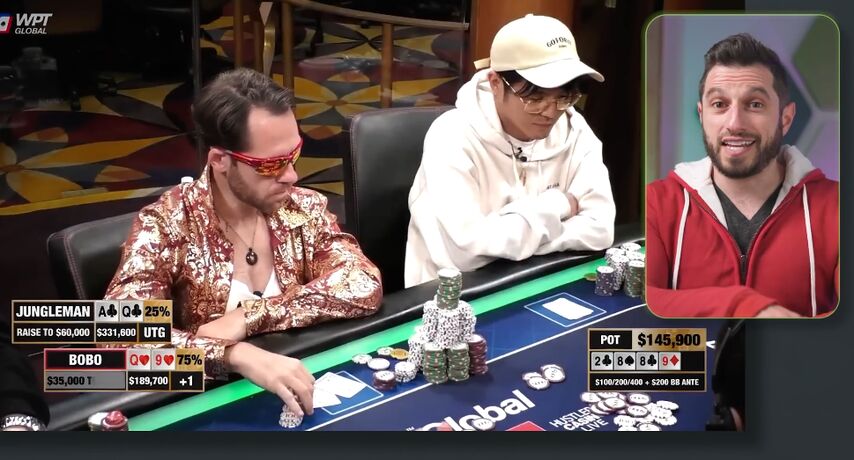
That's quite a departure from the standard! However, Bobo can only punish him if he makes small turn bets with trips often enough.
Few players are able to properly balance their sizings, especially in such a rare situation – very deep stacks, very tight positions, and a lot of action on a board that is very difficult to hit. No one wins in such spots, which means that there is no ready-made strategy, you have to come up with it on the fly. In this situation, the player most often just looks at his cards and plays not a range, but a specific hand. With top pair, Bobo wants to get some value, defend against overcards, and check the next river. With he would have played completely differently – at least that's what Jungleman thought, and I'm inclined to agree with him.
Such reads are not 100% accurate, but if you are confident enough in them, you can deviate radically from the standard. Jungleman's check-raise on the turn looks very strong.
Bobo calls – he is not ready to give up yet. He has a good hand and the pot odds are also good. He'll hit a nine 5% of the time, occasionally win a showdown after checks on the river, or, what the hell, try to catch a bluff on the river. All in all, you can't blame him for this call.
As a reminder, this hand is played with $200/$400 blinds, not $500/$1,000 like many other hands I cover on the channel. If you count in the big blinds, the pot was very bloated.
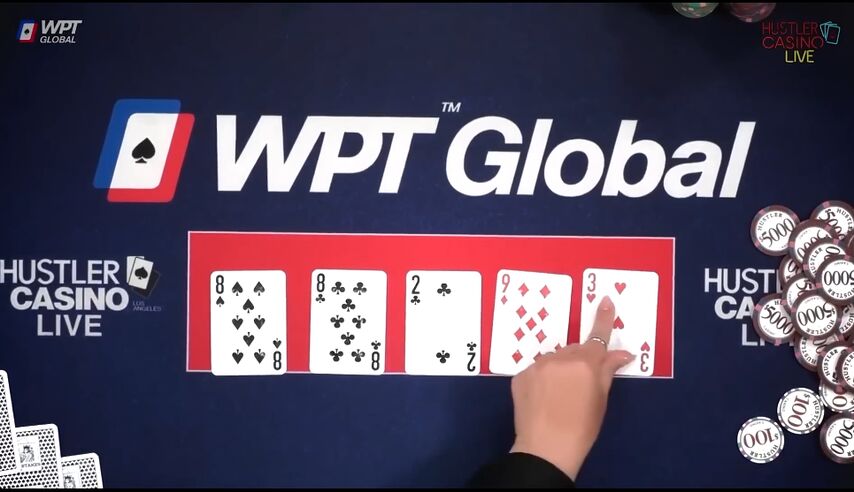
There is $180,900 in the pot and $154,700 in Bobo's stack. Jungleman has to decide whether to bluff or not. For a successful bluff, two conditions must be met. Firstly, the opponent should not have combinations from trips and above. Secondly, he must fold everything else often enough. A mistake on any point – and the bluff on the river will be minus.
In addition, Jungleman blocks the ace and queen of clubs, which is not good for him, because it reduces the number of automatic folds of the opponent with bluffs.
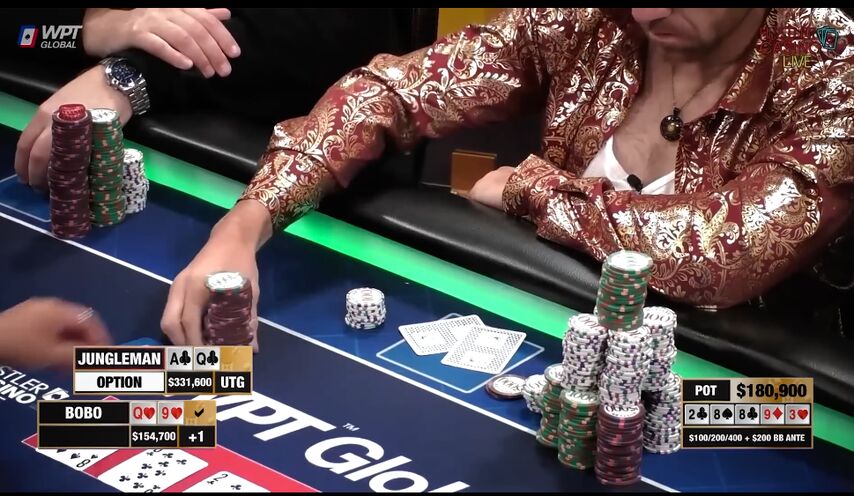
Nevertheless, he bets – and not all-in, but $126,000.
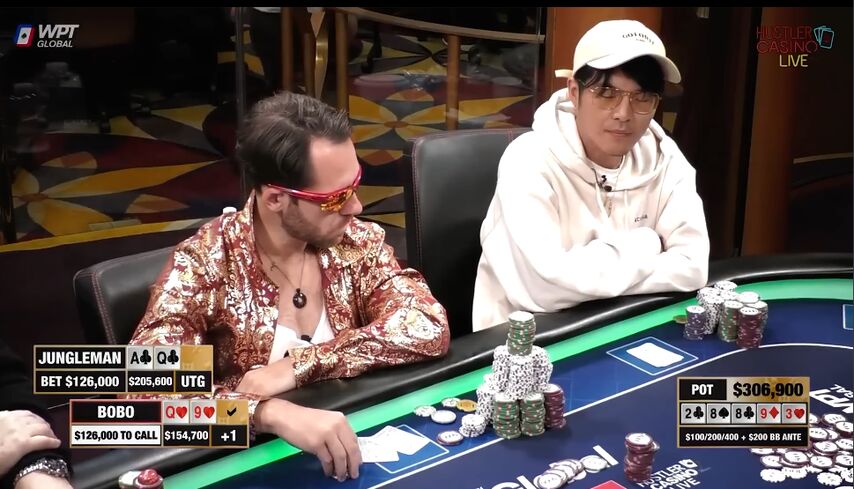
2/3 of the pot instead of all-in... I don't quite understand the meaning of his sizing. Perhaps Jungleman is trying to play off their history, which makes a thin addition, or he believes that the villain will fold equally often to 2/3 of the pot and to all-in, which will save almost 30 thousand dollars in case of failure.
Completely non-standard and very unusual bluff! But what else can you expect from Jungleman?
And the opponent folds...
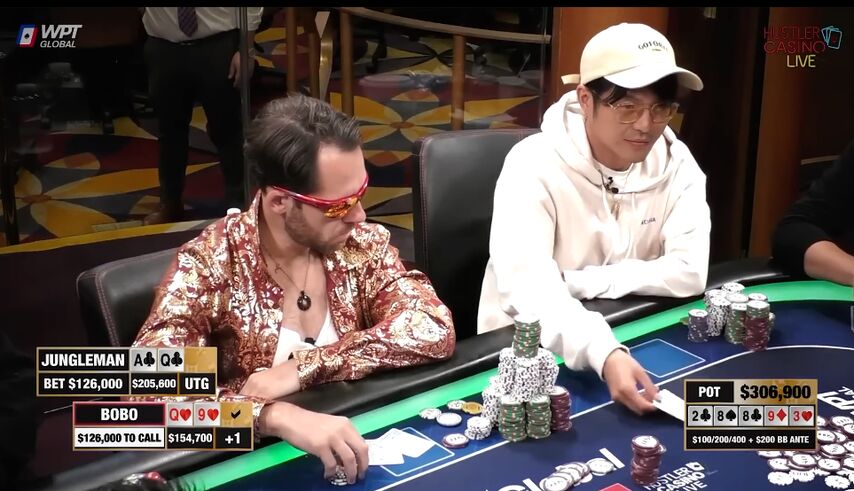
– Show your bluff! Jangleman is asked.
– What a bluff? I can't bluff here, I refuse.
“No, you can, you can,” his colleagues convince him. – Stop breaking, show me already!
– Show the truth? Do you wanna take a look? – Interested in from the opponent.
– Come on.
– "OK. Maybe I was better, maybe I was bluffing,” Jungleman says and turns over the cards.
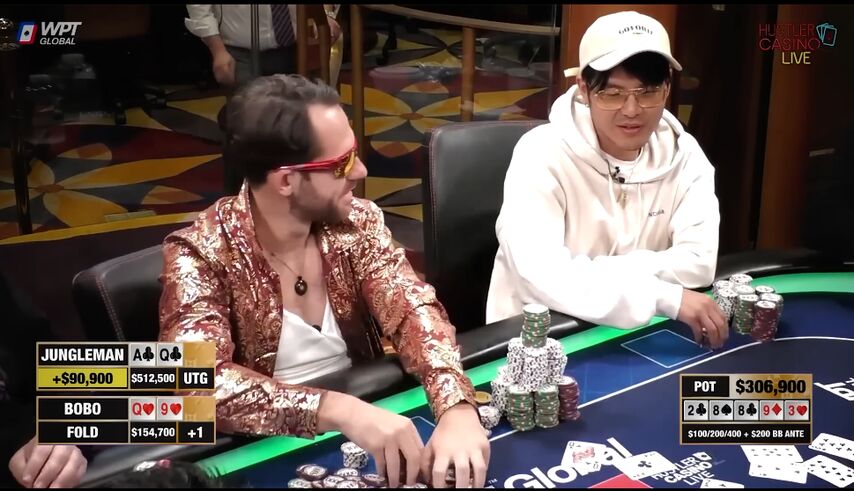
“Uh-oh,” Bobo says, nodding his head respectfully.
Well, his fold seems very standard to me – he is at the very bottom of his range, except for . This is a line for tens or jacks, and with a nine, it should not be in this pot at all! However, he also beats bluffs – and Jungleman was bluffing this time.
I think the key takeaway from today's hand is how much the perceived imbalance in the opponent's strategy can turn the game around. Develop observational skills – and, of course, try to correctly balance your own lines. Ask yourself: how will I play with the strongest hands in my range in this spot? Will I choose this sizing with them? Is my story true? Will the opponent believe in it?
I hope you enjoyed this Jungleman's bluff and learned something.
